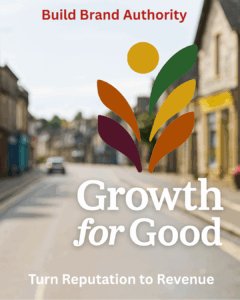
The real cost of growth.
These days, everyone talks about growth. It’s in every podcast, pitch deck, and business blog. But here’s the truth: growth isn’t free, and it’s not simple.
Growing a business in the Highlands can be thrilling, as I know from first-hand experience. But if you’re unprepared, it can drain your energy, overwhelm your team, and reveal weaknesses in your systems. It can stretch your pricing, strain your cash flow, and turn smooth operations into chaos.
The good news? If you spot these hidden costs early, you can make better decisions. This wisdom brings relief, allowing you to scale in a controlled, confident, and truly profitable way.
More sales don’t always mean more success.
Many small businesses think that more sales equal more strength. But revenue is just part of the picture.
Here are the key questions:
- Are you keeping more of what you earn?
- Is your team (or you) heading towards burnout?
- Is your business easier or harder to run?
Growth for Good principle: If growth adds more complexity than value, it isn’t strategic. It’s risky.
Growth demands cash, and lots of it.
Every step forward costs money.
Hiring someone new? That’s more than a salary. It includes onboarding, management time, and ongoing commitment. Landing bigger clients? You face longer payment terms, more upfront effort, and tighter cash flow. Adding a new service or product? Expect higher marketing, support, and distribution costs.
What often happens is this: businesses grow, but the cash from that growth hasn’t come in yet. They spend a lot to get more work, but they’re stuck waiting to be paid.
The reality is simple: growth usually consumes cash before it creates it.
When the Leader Becomes the Logjam
As your business grows, your role must change. You can’t run a ten-person team the same way you did with two.
Yet, many founders maintain a deep involvement in daily operations. They want to approve every decision and oversee every step. This slows everything down.
In business, a bottleneck is anything that hinders progress. Often, that bottleneck is the leader.
Growth for Good mindset: Your job is to shift from doing everything to designing how things work. You’re no longer the engine; you’re the architect who builds the systems and the team. This means stepping back, trusting others, and focusing on strategy rather than daily tasks.
More isn’t always better.
It can feel like progress to offer more services, take on more clients, and expand features. But each decision adds complexity.
Without strong systems, that complexity can chip away at your profits. It can confuse your team, slow down delivery, and unnecessarily complicate things.
For instance, you might create a custom service for one client. It seemed like a great opportunity. However, it now takes 40% more time to deliver, and no other client is interested. That’s not growth; that’s drift.
Focus on what scales. Build repeatable offers. Keep things clear and efficient. Don’t confuse variety with value.
Growth isn’t always the right move.
We should say this more often: not all growth is good growth, and we should understand the real cost of growth.
Before chasing the next big opportunity, ask yourself:
- Can we handle more work without breaking?
- Will this improve our bottom line, or just add pressure?
- Do we have the people, processes, and cash to do it well?
Growth for Good strategy: Only grow what’s ready to scale. Evaluate your team, systems, and finances. This proactive approach ensures you can handle what’s ahead, letting you focus and grow without losing control.
That’s how you stay focused. That’s how you grow without losing control. That is what this series of articles aims to explore, perhaps sparking a few ideas and generating more conversation about our shared experiences.
The Next Step: Unlocking Hidden Capital
If the real cost of growth is stress, complexity, and cash strain, the best move might not be to chase more work. Instead, look inside your business and find the capital that’s already there. Free up time, tighten systems, and streamline costs. That’s where real, sustainable growth begins.
For even deeper insights, you can read a Robert Gordon University academic study on this subject here
